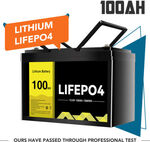Similar to a previous deal posted for this 100Ah Lithium battery, different eBay seller (though possibly same as outbaxcamping anyway)
These have a 50A BMS so not possible to run more than 600W and I don't think it's possible to run them serial or parallel.
I purchased this from this seller a little while back. While I haven't done a full capacity test, on charging it took 70Ah and have run a constant 50A draw for 10 minutes (I only have a 600W inverter so couldn't push it any higher with what I had during the test).
Features
- Nominal Capacity: 100Ah
- Usable Capacity: 100Ah
- Nominal Voltage: 12.8V
- Watt Hour : 1280wh
- Charge Voltage: 14.6V
- Discharge Cut-off Voltage: 10V
- Charge Method: CC/CV
- Charger: 14.6V20A
- Max.Charge Current: 50A
- Max.Continues Discharge Current: 50A
- Cycle Life: 2000times
- Dimension: L306 * W169 * H215mm
- Working Temperature Range: Charge:0°C to 45°C. Discharge:-20°C to 60°C
- Storage Temperature: -10°C to 50°C





Does having a BMS mean it can be connected to a dumber non Li specific battery charger?